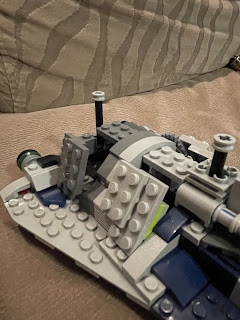Introducing… ArrowHead, the fastest craft I’ve ever built.
The design was mainly based on a search-and-rescue theory. Simply put, this plane speeds in, drops the loading bay and zooms off with its target. Its speed comes from not needing to generate lift using wings, the entire plane is suspended with a charm instead.
Engines at the back of the plane provide thrust.
The entire thing is relatively heavily armored, with plates and armor that cover the whole passenger section : a success in terms of technical building. The entire plane still looks sleek albeit the passenger section because of the curved plates laid in.
A view of the passenger section. The knob to turn the cargo loading bay down is visible from here. The entire floor section drops down to accommodate passengers easily. This way, the craft can snatch up targets quickly.
The cargo bay is lowered with a simple winch mechanism which is normally kept in place by a lock. It can be removed easily.
The interior is spacious enough to store 2 LEGO minifigures without excessive headgear. Slight walls on the bottom can be lowered to form a ramp.
The panels on the side can be hinged slightly for changes.
And lastly, a quick video of the mechanism.
Thank you for reading my blog .















